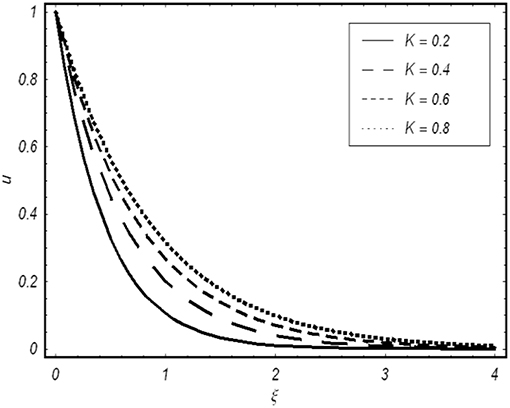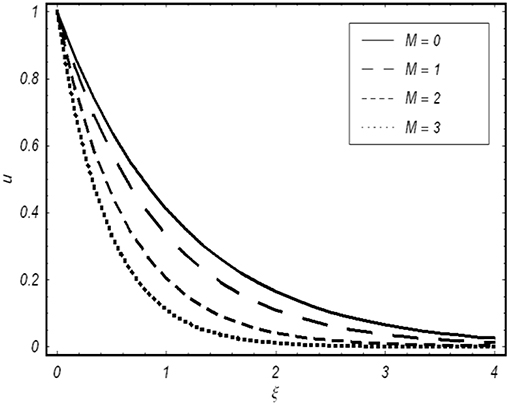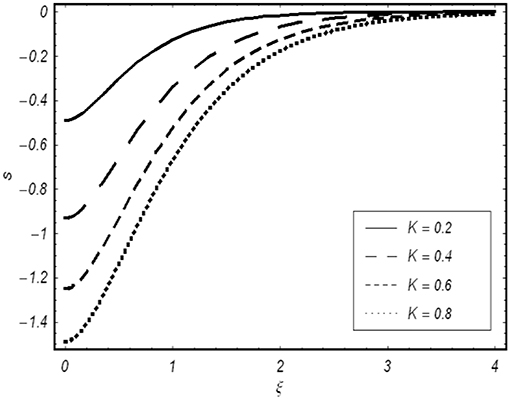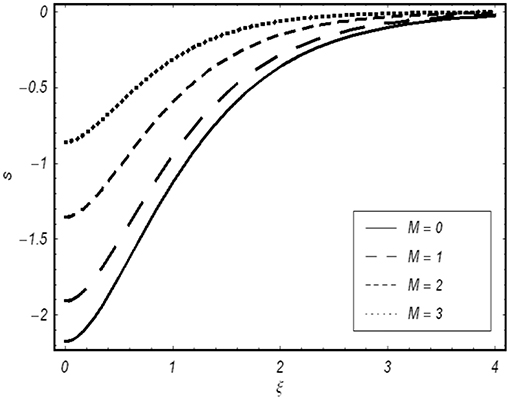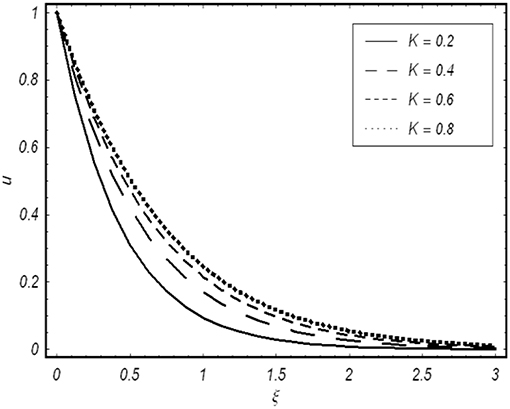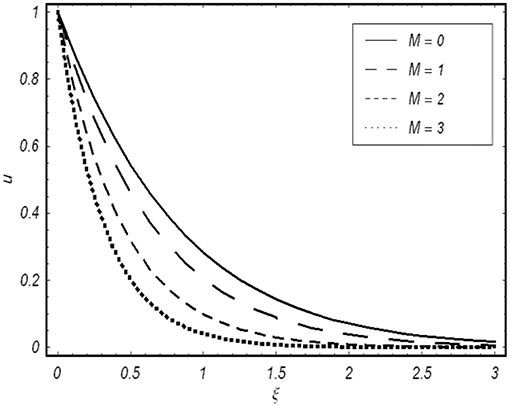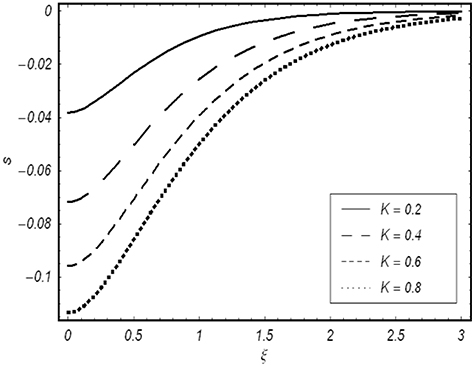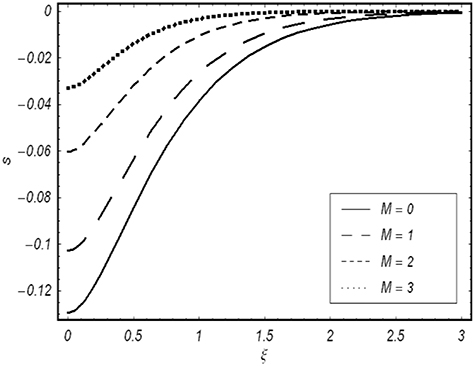- 1Mathematical Sciences Department, College of Science, Princess Nourah Bint Abdulrahman University, Riyadh, Saudi Arabia
- 2Faculty of Mathematics and Statistics, Ton Duc Thang University, Ho Chi Minh City, Vietnam
Time-dependent magnetohydrodynamic (MHD) motion of a generalized Burgers' fluid (GBF) is investigated in this article. GBF is a highly complicated non-Newtonian fluid and is of highest degree in the class of rate type fluids. GBF is taken electrically conducting by using the restriction of small magnetic Reynolds number. Darcy's law has been used here in its generalized form using the GBF constitutive relation; hence, the medium is made porous. The impulsive motion in the fluid is induced due to sudden jerk of the plate. Exact expressions for velocity as well as for shear stress fields are obtained using the Laplace transform method. The solutions for hydrodynamic fluid (absence of MHD) in a non-porous medium as well as those for a Newtonian fluid (NF) executing a similar motion are also recovered. Results are sketched in terms of several plots and discussed for embedded parameters. It is found that the Hartmann number and porosity of the medium have strong influence on the velocity and shear stress fields.
Introduction
Most of the fluid problems (published literature), or fluid problems with heat transfer or heat and mass transfer together, are computed numerically due to the difficult nature of these problems. Indeed, the exact solutions for these problems are either not possible or quite difficult to obtain. These difficulties further increase if one is interested to solve such a problem using the integral transform techniques such as Laplace transform, Fourier transform, etc. In the Laplace transform, particularly the most difficult job is how to take the inversion. Therefore, some of the researchers are then using numerical inversion to somehow solve the inversion problem. However, such solutions are then not the so-called pure exact solutions. Among the interesting studies on exact solutions and, of course, the pioneering work includes the work of Rajagopal [1], where he studied non-Newtonian second-grade fluid for different flow motions and obtained exact solutions for each flow case. The flow was unsteady unidirectional and one-dimensional. Eight different flow cases were discussed. This work was then extended in 2007 by Hayat et al. [2] for the case of MHD flow and porous medium. More exactly, the fluid was taken electrically conducted and passing through a porous medium. They discussed seven different flow situations and obtained exact solution either by perturbation method or Fourier transform method. Other interesting studies on exact solutions include the work of Erdogan [3], Erdogan and Imrak [4], and Tan and Masuoka [5, 6]. Hayat et al. [7, 8] established for rotating flows exact analytic solutions for two different types of non-Newtonian fluids, namely, the second-grade fluid and the Maxwell fluid. They considered transient problems in both cases with combined effects of MHD and porosity. The obtained exact solutions were discussed for various embedded parameters and concluded. Fetecau et al. [9] in a short note investigated analytically the Stokes' second problem (SSP) for Newtonian fluids (NF) flow. Fetecau and Fetecau [10] considered an unsteady problem of a Maxwell fluid (MF, non-Newtonian) over a rigid plate moved due to a sudden jerk. In another paper, Fetecau and Fetecau [11] extended the idea of MF to an Oldroyd-B fluid (OBF, non-Newtonian) and examined exact solutions for the first problem of Stokes'. Vieru et al. [12] also determined exact solution for the flow situation of an OBF over an infinite rigid plate.
In the group of viscoelastic fluids, Burgers' fluids and the corresponding generalized Burgers' fluids (GBFs) are less studied in the literature compared to other fluids in that group. Indeed, the resulting equations based on their complicated constitutive relations are not easy to handle. The exact solutions for these fluids problems are not possible unless we impose several assumptions. Even then, the exact solutions for these fluid problems are limited to certain well-known problems. Some famous fluid problems for Burgers or GBFs have been studied in Ravindran et al. [13], Hayat et al. [14], Khan et al. [15], Tong and Shan [16], Xue and Nie [17], Hayat et al. [18], Vieru et al. [19], Khan et al. [20–22], Fetecau et al. [23] and related references therein. However, for several other problems, such solutions are either too much complicated or even not possible. Such a complication even increases if the problem under consideration is composed of fractional differential equations, such as the problem considered in these articles on different aspects of sciences and engineering [24–36]. Some other related studies regarding fluid dynamics problems can be seen in Waqas et al. [37], Marin et al. [38], Jamil [39], and Jamil et al. [40, 41]. Roberts and Kaufman [42] is used for some of the Laplace inversion formulas needed for this work.
The main purpose of the present article is to study the time-dependent flow of GBF (incompressible) over an infinite (in horizontal-direction) rigid plate given sudden jerk. Simultaneous effects of MHD and porosity are also taken into consideration.
Exact analytic solutions are obtained for the dimensionless fluid velocity and non-trivial shear stress exerted by the fluid on the plate. Laplace transform is indeed a suitable method to solve this problem. Clearly, these solutions satisfy the given imposed conditions [initial and boundary conditions (IBCs)] and can produce other exact analytic solutions for other non-Newtonian fluids problems such as Burgers' fluids, OBFs, and Maxwell fluids performing a similar type of motion. Exact solutions for Newtonian fluids performing the same motion can also be obtained as a special case by vanishing all other non-Newtonian parameters. Graphical results are plotted and discussed for embedded parameters. Solutions for other fluids (generalized Burger fluids without MHD and porosity effects, Newtonian fluids) in limiting sense are also recovered.
Problem Formulation and Integral Transform Solution
The problem formulation states that an incompressible flow strongly depends on time (unsteady flow) of a highly non-Newtonian fluid known as GBF lies in a semi-infinite porous space y > 0; i.e., the fluid is over a rigid plate kept at y = 0. The axes (x−axis and y−axis) are taken perpendicular to each other; i.e., the x−axis is taken in the flow direction while the y−axis is chosen normal to the direction of the flow. MHD effect is considered under which the fluid behaves like an electrically conducting liquid under the influence of an applied magnetic field such that the induced magnetic field is v(0, t) = V, v(y, t) → 0 as y → ∞; t > 0, neglected assuming that magnetic Reynolds number is too small. GBF is initially taken at rest (for time t = 0); however, for time t > 0, the plate is give a sudden jerk (impulsive motion of the plate) and the fluid starts with the same impulsive motion. The scenario stated above is formulated in the form of partial differential equation with physical boundary and initial conditions as given below (for detailed analysis of the governing equation, one may refer to Xue and Nie [17] and Hayat et al. [18]):
in which v is the velocity component in x−direction, ρ is the fluid density, μ is the dynamic viscosity, δ is the finite electrical conductivity of the fluid, φ(0 < φ < 1) is the porosity, k > 0 is the permeability of the porous medium, λ and λr(< λ) are respectively the relaxation and retardation times, γ and γ1 are the material constants having the dimensions as the square of time, and V denotes the reference velocity.
The problem described by Equations (1)–(3), after using non-dimensional quantities, takes the following form:
where
In the transformed q−plane, Equations (5)–(8) give
in which q is a Laplace transform parameter and
The transformed solution of Equation (11) under the boundary conditions (12) gives
In obtaining we write Equation (14) as
with
Expressing Equation (16) after Laplace inversion gives
To find using the inversion formula for compound functions
where f(τ) = L−1{F(q)} and g(u, τ) = L−1{e−uw(q)}. Choosing then
and
In order to find g(u, τ) = L−1{e−uw(q)}, we express w(q) as follows
where q1 and q2 are the roots of the equation Thus,
with
Let us denote
and
where J1(·) denotes the Bessel function of first kind of order one and then finally one has
and L−1{e−αq} = δ(τ−α). Here δ(·) indicates the Dirac delta function.
Insertion of Equation (26) into Equation (21) leads to the following result:
Taking into consideration Equations (27) and (18), one obtains
Setting u = dv/a into Equation (28) and using the following property:
we arrive at the following result:
Now, the expression for the shear stress can be easily found from Equation (6) and hence finally we get.
Limiting Cases
Absence of MHD and Porosity
In limiting sense, when the magnetic effect is absent (M = 0) and the medium is non-porous, then the above solutions take the following forms:
with the following expressions for η3 and η4:
It is important to note that if we put into the governing Equation (6) and solve along with Equation (7) with the prescribed boundary and initial conditions, we get the same expressions for velocity and shear stress as given above.
Newtonian Fluid
For Newtonian fluid, we make λ, λr, γ , and γ1 equal to zero or equivalently λ = λr = γ = γ1, then the solutions (30) and (31) reduce to
Now, taking λ = λr = γ = γ1 in the governing Equation (6) and solving the resulting equations with the given boundary and initial conditions, we get
where
Taking the Laplace inverse of Equation (38), we get
The convolution product of u1(τ) = 1 and u2(ξ, τ) gives
The corresponding shear stress can be easily found by using Equation (6); i.e.,
Using a similar method as in the case of velocity, the final expression for the shear stress is given as follows:
Here, we noted that in both cases, i.e., from the final solutions given by Equations (30) and (31) and from the governing Equations (5) and (6), we obtained the same exact results for velocity and shear stress given by Equations (35), (36), (40), and (42), respectively. Indeed, this provides a useful check of correctness.
Numerical Results and Discussion
Figure 1 is plotted for K = 0.2, 0.4, 0.6, 0.8 when M = 0.2, α = 0.9, β1 = 0.5, β = 0.8 and τ = 0.5, whereas Figures 2, 4 are sketched for M = 0, 1, 2, 3 when K = 2, α = 0.9, β1 = 0.5, β = 0.8, and τ = 0.5. Figures 1–4 have been displayed to see the influence of Hartmann number M and porosity parameters K on the fluid velocity and the corresponding shear stress of a GBF. To check the effects of M and K on the fluid velocity and related shear stress for a Newtonian fluid, Figures 5–8 are sketched. Figures 5, 7 are plotted for different values of K when M = 0.2 and τ = 0.5, whereas Figures 6, 8 are prepared for various values of M when K = 2 and τ = 0.5. Note that Figures 1–8 provide a comparison of velocity field and the related shear stress for the case of GBF with that of a Newtonian fluid. Figure 1 shows the influence of K on the Burgers' fluid velocity; it can be noticed that velocity increases with the increasing values of K, due to the decrease in opposing forces. In Figure 2, the impact of M is shown on fluid velocity; from this figure, it is noticed that velocity is a decreasing function of M. This is because the greater values of M enhance the Lorentz forces, which are the opposing forces. The same behavior is noticed in Figures 5, 6 for Newtonian fluid. Figure 3 is plotted in order to show the effect of K on shear stress; the shear stress decreases with the increasing values of K. The behavior of shear stress is noticed for different values of M in Figure 4. It is observed that the shear stress increases with the increasing values of M. Figures 7, 8 also show the same behavior of shear stress for Newtonian fluid.
Data Availability Statement
All datasets generated for this study are included in the article/supplementary material.
Author Contributions
AA formulated the problem. IK solved the problem and discussed results.
Funding
This research was funded by Deanship of Scientific Research at Princess Nourah bint Abdulrahman University (Grant No. 39/S/269:  ).
).
Conflict of Interest
The authors declare that the research was conducted in the absence of any commercial or financial relationships that could be construed as a potential conflict of interest.
References
1. Rajagopal KR. A note on unsteady unidirectional flows of a non-Newtonian fluid. Int J Non Linear Mech. (1982) 17:369–73.
2. Hayat T, Khan I, Ellahi R, Fetecau C. Some MHD flows of a second grade fluid through the porous medium. J Porous Media. (2008) 11:389–400. doi: 10.1615/JPorMedia.v11.i4.50
3. Erdogan ME. A note on an unsteady flow of a viscous fluid due to an oscillating plane wall. Int J Non Linear Mech. (2000) 35:1–6. doi: 10.1016/S0020-7462(99)00019-0
4. Erdogan ME, Imrak CE. On some unsteady flows of a non-Newtonian fluids. Appl Math Model. (2007) 31:70–180. doi: 10.1016/j.apm.2005.08.019
5. Tan WC, Masuoka T. Stokes first problem for a second grade fluid in a porous half space with heated boundary. Int J Non-Linear Mech. (2005) 40:515–22. doi: 10.1016/j.ijnonlinmec.2004.07.016
6. Tan WC, Masuoka T. Stokes first problem for an Oldroyd-B fluid in a porous half space. Phys Fluid. (2005) 17:023101–7. doi: 10.1063/1.1850409
7. Hayat T, Fetecau C, Sajid M. Analytical solution for MHD transient rotating flow of a second grade fluid in a porous space. Non Linear Anal Real World Appl. (2008) 9:1619–27. doi: 10.1016/j.nonrwa.2007.04.006
8. Hayat T, Fetecau C, Sajid M. On MHD transient flow of a Maxwell fluid in a porous medium and rotating frame. Phys Lett A. (2008) 372:1639–44. doi: 10.1016/j.physleta.2007.10.036
9. Fetecau C, Vieru D, Fetecau C. A note on the second problem of Stokes' for Newtonian fluids. Int J Non Linear Mech. (2008) 43:451–7. doi: 10.1016/j.ijnonlinmec.2007.12.022
10. Fetecau C, Fetecau C. A new exact solution for the flow of a Maxwell fluid past an infinite plate. Int J Non Linear Mech. (2002) 38:423–7. doi: 10.1016/S0020-7462(01)00062-2
11. Fetecau C, Fetecau C. The first problem of Stokes' for an Oldroyd-B fluid. Int J Non-Linear Mech. (2003) 38:1539–44. doi: 10.1016/S0020-7462(02)00117-8
12. Vieru D, Nazar M, Fetecau C, Fetecau C. New exact solutions corresponding to the first problem of Stokes' for Oldroyd-B fluids. Appl Math Comput. (2008) 55:1644–52. doi: 10.1016/j.camwa.2007.04.040
13. Ravindran P, Krishnan JM, Rajagopal KR. A note on the flow of Burgers' fluid in an orthogonal rheometer. Int J Eng Sci. (2004) 42:1973–85. doi: 10.1016/j.ijengsci.2004.07.007
14. Hayat T, Fetecau C, Asghar S. Some simple flows of a Burgers' fluid. Int J Eng Sci. (2006) 44:1423–31. doi: 10.1016/j.ijengsci.2006.08.008
15. Khan M, Maqbool K, Hayat T. Influence of Hall current on the flows of a generalized Oldroyd-B fluid in the porous space. Acta Mech. (2006) 184:1–13. doi: 10.1007/s00707-006-0326-7
16. Tong D, Shan L. Exact solutions for generalized Burgers' fluid in an annular pipe. Meccanica. (2009) 44:427–31. doi: 10.1007/s11012-008-9179-6
17. Xue C, Nie J. Exact solutions of Stokes first problem for heated generalized Burgers' fluid in a porous half space. Non Linear Anal Real World Appl. (2008) 9:1628–37. doi: 10.1016/j.nonrwa.2007.04.007
18. Hayat T, Khan SB, Khan M. Exact solution for rotating flows of a generalized Burgers' fluid in a porous space. Appl Math Model. (2008) 32:749–60. doi: 10.1016/j.apm.2007.02.011
19. Vieru D, Hayat T, Fetecau C, Fetecau C. On the first problem of Stokes' for Burgers' fluid, II: the Cases γ = λ2/4 and γ>λ2/4. Appl Math Comput. (2008) 197:76–86. doi: 10.1016/j.amc.2007.07.033
20. Khan M, Ali SH, Fetecau C. Exact solutions of accelerated flows for a Burgers' fluid. I. The case γ < λ2/4. Appl Math Comput. (2008) 203:881–94. doi: 10.1016/j.amc.2008.05.121
21. Khan M, Ali SH, Fetecau C. Exact solutions of accelerated flows for a Burgers' fluid. II. The cases γ = λ2/4 and γ>λ2/4, Z. Angew Math Phys. (2009) 60:701–22. doi: 10.1007/s00033-008-7155-6
22. Khan M, Anjum A, Fetecau C. On exact solutions of Stokes second problem for a Burgers' fluid, I. The case γ < λ2/4, Z. Angew Math Phys. (2009) 61:697–720. doi: 10.1007/s00033-009-0025-z
23. Fetecau C, Vieru D, Hayat T, Fetecau C. On the first problem of Stokes for Burgers' fluid, I: Case γ < λ2/4. Int J Non-Linear Anal. (2009) 10:2183–94. doi: 10.1016/j.nonrwa.2008.04.002
24. Kumar D, Singh J, Baleanu D. Analytic study of Allen-Cahn equation of fractional order. J Math Anal Appl. (2017) 9:31–40.
25. Gupta S, Kumar D, Singh J. An efficient computational approach for generalized Hirota-Satsuma coupled KdV equations arising in shallow water waves. Waves Wavelets Fractals Adv Anal. (2017) 3:14–30. doi: 10.1515/wwfaa-2017-0002
26. Kumar D, Singh J, Baleanu D. Modified Kawahara equation within a fractional derivative with non-singular kernel. Therm Sci. (2018) 22:789–96. doi: 10.2298/TSCI160826008K
27. Singh J, Kumar D, Baleanu D. On the analysis of fractional diabetes model with exponential law. Adv Diff Equ. (2018) 2018:231. doi: 10.1186/s13662-018-1680-1
28. Kumar D, Singh J, Baleanu D. A new fractional model for convective straight fins with temperature-dependent thermal conductivity. Therm Sci. (2018) 22:2791–802. doi: 10.2298/TSCI170129096K
29. Prakash A, Verma V, Kumar D, Singh J. Analytic study for fractional coupled Burger's equations via sumudu transform method. Nonlinear Eng. (2018) 7:323–32. doi: 10.1515/nleng-2017-0090
30. Kumar D, Singh J, Baleanu D, Rathore S. Analysis of a fractional model of Ambartsumian equation. Eur Phys J Plus. (2018) 133:259. doi: 10.1140/epjp/i2018-12081-3
31. Kumar D, Tchier F, Singh J, Baleanu D. An efficient computational technique for fractal vehicular traffic flow. Entropy. (2018) 20:259. doi: 10.3390/e20040259
32. Kumar D, Singh J, Tanwar K, Baleanu D. A new fractional exothermic reactions model having constant heat source in porous media with power, exponential and Mittag-Leffler Laws. Int J Heat Mass Transf. (2019) 138:1222–7. doi: 10.1016/j.ijheatmasstransfer.2019.04.094
33. Kumar D, Singh J, Purohit SD, Swroop R. A hybrid analytical algorithm for nonlinear fractional wave-like equations. Math Model Nat Pheno. (2019) 14:304. doi: 10.1051/mmnp/2018063
34. Kumar D, Singh J, Al Qurashi M, Baleanu D. A new fractional SIRS-SI malaria disease model with application of vaccines, anti-malarial drugs, and spraying. Adv Differ Equ. (2019) 2019:278. doi: 10.1186/s13662-019-2199-9
35. Yang XJ, Tenreiro Machado JA. A new fractal nonlinear Burgers' equation arising in the acoustic signals propagation. Math Method Appl Sci. (2019) 14:304. doi: 10.1002/mma.5904
36. Yang XJ, Tenreiro Machado JA, Baleanu D. Exact traveling-wave solution for local fractional boussinesq equation in fractal domain. Fractals. (2017) 25:1–19. doi: 10.1142/S0218348X17400060
37. Waqas H, Khan SU, Imran M, Bhatti MM. Thermally developed Falkner–Skan bioconvection flow of a magnetized nanofluid in the presence of a motile gyrotactic microorganism: buongiorno's nanofluid model. Physica Scripta. (2019) 94:115304. doi: 10.1088/1402-4896/ab2ddc
38. Marin M, Vlase S, Ellahi R, Bhatti MM. On the partition of energies for the backward in time problem of thermoelastic materials with a dipolar structure. Symmetry. (2019) 11:863. doi: 10.3390/sym11070863
39. Jamil M. First problem of Stokes for generalized Burgers' fluids. ISRN Math Phys. (2012) 2012:831063. doi: 10.5402/2012/831063
40. Jamil M, Rauf A, Zafar AA, Khan NA. New exact analytical solutions for Stokes' first problem of Maxwell fluid with fractional derivative approach. Comput Math Appl. (2011) 62:1013–23. doi: 10.1016/j.camwa.2011.03.022
41. Jamil M, Khan NA, Imran MA. New exact solutions for an Oldroyd-B Fluid with Fractional Derivatives: Stokes' first problem. Int J Nonlinear Sci Num Simul. (2013) 14:443–51. doi: 10.1515/ijnsns-2011-024
42. Roberts GE, Kaufman H. Table of Laplace Transforms. Philadelphia, PA: W.B. Saunders Company (1968).
Nomenclature
Keywords: time-dependent flow, MHD, generalized Burgers' fluid, generalized Darcy's law, Laplace transform
Citation: Alqahtani AM and Khan I (2020) Time-Dependent MHD Flow of Non-Newtonian Generalized Burgers' Fluid (GBF) Over a Suddenly Moved Plate With Generalized Darcy's Law. Front. Phys. 7:214. doi: 10.3389/fphy.2019.00214
Received: 28 September 2019; Accepted: 21 November 2019;
Published: 17 January 2020.
Edited by:
Devendra Kumar, University of Rajasthan, IndiaReviewed by:
Muhammad Mubashir Bhatti, Shanghai University, ChinaNajeeb Khan, University of Karachi, Pakistan
Copyright © 2020 Alqahtani and Khan. This is an open-access article distributed under the terms of the Creative Commons Attribution License (CC BY). The use, distribution or reproduction in other forums is permitted, provided the original author(s) and the copyright owner(s) are credited and that the original publication in this journal is cited, in accordance with accepted academic practice. No use, distribution or reproduction is permitted which does not comply with these terms.
*Correspondence: Ilyas Khan, aWx5YXNraGFuQHRkdHUuZWR1LnZu
 Aisha M. Alqahtani
Aisha M. Alqahtani Ilyas Khan2*
Ilyas Khan2*